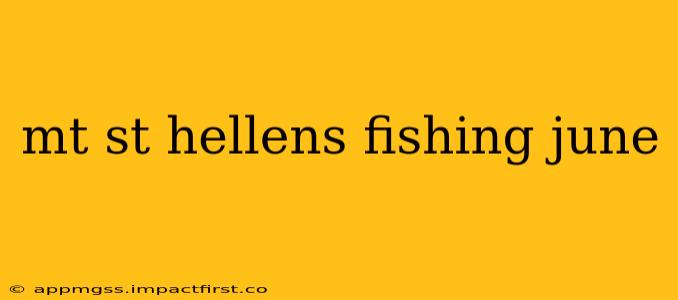June offers a fantastic opportunity to experience the unique fishing opportunities around Mount St. Helens. The snowmelt is in full swing, filling rivers and streams, and the weather is generally pleasant, making it an ideal time for a fishing trip. However, conditions can vary, so preparation is key. This guide will cover everything you need to know about fishing near Mount St. Helens in June.
What kind of fish can I catch near Mt. St. Helens in June?
June fishing near Mt. St. Helens typically offers opportunities to catch a variety of species, depending on the specific location and water body. You can expect to find:
- Rainbow Trout: These are a prevalent species in many of the area's rivers and streams, often thriving in the cooler, clearer waters.
- Cutthroat Trout: Depending on the location, you might encounter both native and introduced cutthroat trout.
- Steelhead: While less common in June, some early-run steelhead may still be present in certain rivers. This depends greatly on water conditions.
- Smallmouth Bass: These can be found in some of the lakes in the area, particularly as the water warms.
It's always advisable to check with local fishing reports and regulations for the most up-to-date information on species availability.
What are the best fishing spots near Mt. St. Helens in June?
Several excellent fishing spots surround Mount St. Helens. However, access and fishing conditions can vary, so research is crucial. Some popular areas include:
- The Toutle River: A large river system with varied fishing opportunities, offering different experiences depending on the section you choose. It's known for its rainbow trout population.
- The Lewis River: Another significant river system near the volcano, the Lewis River also holds good numbers of trout.
- Local Lakes: Several smaller lakes in the surrounding area offer opportunities to target different species, including bass and trout. Check local regulations regarding access and permitted fishing methods.
Remember that access to some areas may be limited due to the volcano's history and ongoing monitoring. Always check current access restrictions before heading out.
What are the fishing regulations for Mt. St. Helens in June?
Before you cast your line, it's crucial to understand and adhere to Washington State's fishing regulations. These regulations cover licensing requirements, catch limits, size restrictions, and permitted fishing methods. Failure to comply can result in significant fines. You can find the most up-to-date regulations on the Washington Department of Fish and Wildlife (WDFW) website. Always check before you go, as regulations can change.
What is the weather like near Mt. St. Helens in June?
June weather near Mount St. Helens can be unpredictable. While generally pleasant, you should expect fluctuations in temperature and potential for rain. Be prepared for both sunshine and showers, and pack layers of clothing accordingly. Higher elevations will typically be colder than lower elevations. Check the forecast before your trip and pack accordingly.
What gear should I bring fishing near Mt. St. Helens in June?
Proper gear is essential for a successful and safe fishing trip. Consider bringing:
- Fishing License: Ensure you have the appropriate Washington State fishing license.
- Fishing Rods and Reels: Select rods and reels suitable for the types of fish you plan to target.
- Fishing Line and Lures: Bring a variety of lures and flies to increase your chances of success.
- Waders (Optional): Depending on the location and fishing method, waders can be beneficial, especially in early June when water levels are high.
- Rain Gear: Be prepared for potential rain showers.
- Warm Clothing: Temperatures can fluctuate, particularly at higher elevations.
- Appropriate Footwear: Wear sturdy, waterproof footwear suitable for navigating potentially uneven terrain.
- First-aid Kit: Always a good idea for any outdoor adventure.
Remember to practice Leave No Trace principles and respect the natural environment while enjoying your fishing trip. A little preparation goes a long way in ensuring a safe and successful angling experience near the majestic Mount St. Helens.
